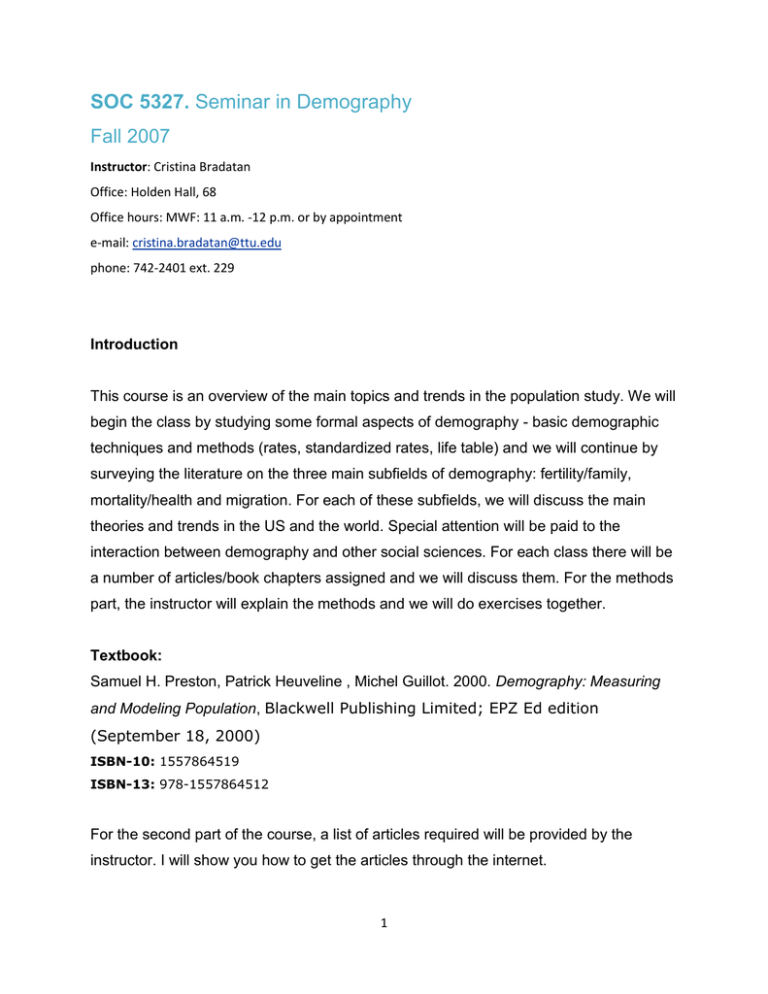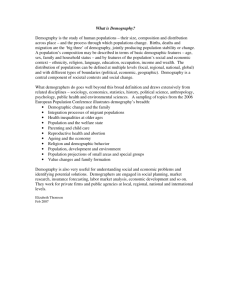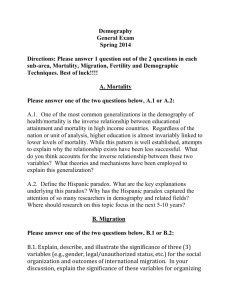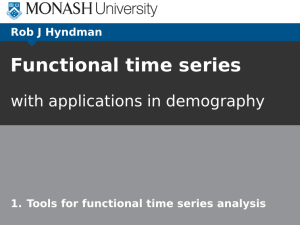SOC 5327. Fall 2007
advertisement

SOC 5327. Seminar in Demography Fall 2007 Instructor: Cristina Bradatan Office: Holden Hall, 68 Office hours: MWF: 11 a.m. -12 p.m. or by appointment e-mail: cristina.bradatan@ttu.edu phone: 742-2401 ext. 229 Introduction This course is an overview of the main topics and trends in the population study. We will begin the class by studying some formal aspects of demography - basic demographic techniques and methods (rates, standardized rates, life table) and we will continue by surveying the literature on the three main subfields of demography: fertility/family, mortality/health and migration. For each of these subfields, we will discuss the main theories and trends in the US and the world. Special attention will be paid to the interaction between demography and other social sciences. For each class there will be a number of articles/book chapters assigned and we will discuss them. For the methods part, the instructor will explain the methods and we will do exercises together. Textbook: Samuel H. Preston, Patrick Heuveline , Michel Guillot. 2000. Demography: Measuring and Modeling Population, Blackwell Publishing Limited; EPZ Ed edition (September 18, 2000) ISBN-10: 1557864519 ISBN-13: 978-1557864512 For the second part of the course, a list of articles required will be provided by the instructor. I will show you how to get the articles through the internet. 1 Course Objectives This class will be an introduction for graduate students to the topic of population studies. After taking this class, the students are expected to:1) be able to interpret basic demographic measures such as TFR or life expectancy; 2) have a good grasp of the main theories in fertility, mortality and migration; 3) they would have a good picture of demographic trends in the US and the world. Course Requirements and Evaluation Students are evaluated according to their performance in all the exams, assignments, final reports and class participation. Distribution of grades Midterm 35% Final examination 35% Assignments 15% Class Participation 15% Grading Scale 93-100 A 90-92 A- 87-89 B+ 83-86 B 80-82 B- 75-79 C+ 70-74 C 66-69 C- 60-65 D 0-59 F 2 Examination There will be two examinations: the first one will be administered after we finish the part with the methods, it will be an online exam and it will consist in multiple choice and short answer questions. For the second examination, I expect you to develop a research proposal on a demographic topic. For the second part of the class, we will have one hour reserved for talking about your projects. Make-up exams will only be administered to those students who have received prior permission to miss the scheduled exam or in case of documented emergencies. Assignments All students are required to do the assignments throughout the semester. For each session, students need to come with a short description of the good and points of the articles assigned. For the methods part, the assignments will consist in exercises. Detailed information of the assignments will be given out during the class. Class Participation It is very important that you attend class regularly. Attendance will be taken every session and will be worth a total of 5 points towards the final grade. It is expected that students read all assigned materials before class, and participate in class discussions. All students will lead a class discussion; let me know by Tuesday, September 25th when (what week) you prefer to lead the discussion. Statement on Disability If you anticipate needing any type of accommodation in this course or have questions about physical access, please tell the instructor as soon as possible. Cheating and plagiarism Academic Dishonesty is defined as: 3 1. Cheating: non-permissible written, visual or oral assistance including that obtained from another student is utilized on examinations, course assignments or projects, is prohibited. The unauthorized possession or use of examination or course related material shall also constitute cheating. 2. Plagiarism: another's work is deliberately used or appropriated without any indication of the source, thereby attempting to convey the impression that such work is the student's own, is prohibited. Any student failing to properly credit ideas or materials taken from another has plagiarized. 3. A student who has assisted another in any of the above mentioned breach of standards shall be considered equally culpable. Tentative Weekly Schedule Week 1. Introduction to population studies (August 28) Week 2 . Demography and its data (September 4) Readings : Ryder, N.B. 1964. “ Notes on the Concept of a Population.” American Journal of Sociology 69:447-463 Nam, Charles B. 1979. “The Progress of Demography as a Scientific Discipline.” Demography 16(4): 485-492. Preston , S. H., P. Heuveline and M. Guillot. 2001. Chapter 1 : Basic Concepts and Measures" in Demography: Measuring and Modeling Population Processes (DMMPP) Caldwell, J. C. 1996. “Demography and Social Science” Population Studies 50: 309316. Cleland, John. 1996. “Demographic Data Collection in the Less Developed Countries.” Population Studies 50: 433-450 4 Greenhalgh, S. 1996. "The Social Construction of Population Science: An Intellectual, Institutional, and Political History of Twentieth Century Demography." Comparative Studies in Society and History 38 (1): 26-66. Week 3 . Demographic methods for mortality (September 11) Readings Chapter 2: “Age-Specific Rates and Probabilities”, in DMMPP Chapter 3: “The Life Table and Single Decrement Processes” in DMMPP Week 4. Demographic methods for mortality (September 18) Readings Chapter 2: “Age-Specific Rates and Probabilities”, in DMMPP Chapter 3: “The Life Table and Single Decrement Processes” in DMMPP Week 5 . Demographic methods for fertility (September 25) Readings Chapter 5: “Fertility and Reproduction”, in DMMPP Examples. Review Week 6 . Exam (October 2) Week 7. Theories of fertility (October 9) Week 8. Fertility and family changes in the US (October 16) Week 9. Fertility and family changes in the world (October 23) Week 10. Mortality and health. Theories (October 30) Week 11. Mortality and health in the US (November 6) Week 12. Theories of migration (November 13) Week 13. Migration trends in the US (November 20) Week 14. Migration trends in the world (November 27) Week 15. Presentations (December 4) Week 16. Presentations (December 11) 5




